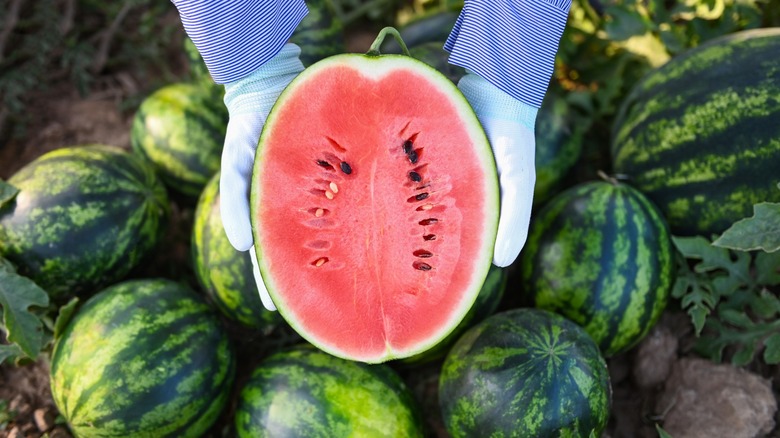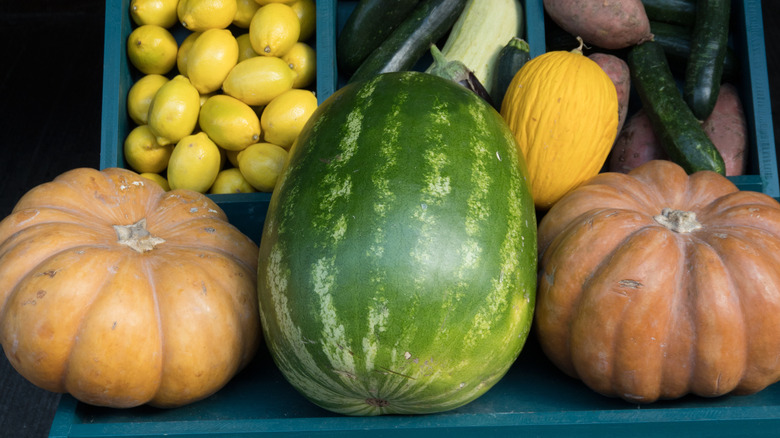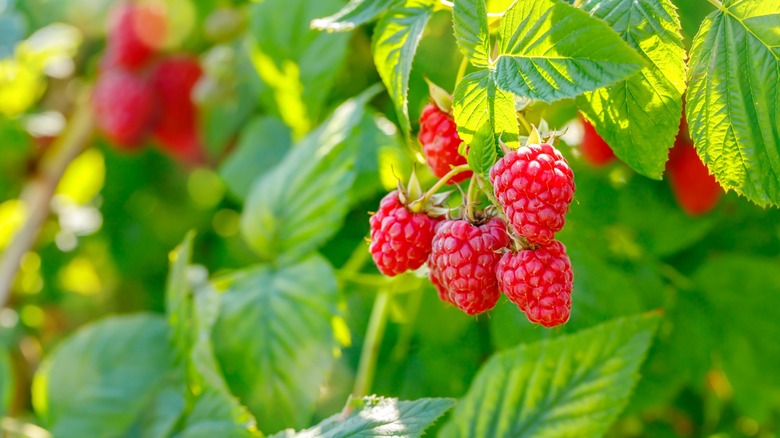Watermelon Is A Berry And We Just Have To Accept That
We often think of berries as those cute, bite-sized fruits you can sprinkle on top of a bowl of morning oats or pour into a blender for a smoothie. You know, pretty much anything that ends with "berry." Well, except for strawberries (not berries at all) – and, technically, blackberries. And raspberries. Maybe boysenberries. They're all aggregates. But blueberries? Definitely berries.
In the highly specific and scientific world of botany, "berry" means a whole lot more than just waltzing around with the suffix "-berry." True berries actually range in all different types of sizes, from blueberries to bananas to watermelons. Yes, watermelons. That's because, in the technical definition of the term, "berry" refers to any fruit that has multiple seeds on the inside without any sort of hardened core.
To elaborate: Everything comes down to layers. Fruits broadly have three sections. The outermost layer is the epidermis or skin, which is only sometimes eaten — think blueberries or another example of a true berry, grapes. Next comes the pericarp, which is a fancier way of naming the fleshy, edible part of the fruit. This is split into three smaller sections called the exocarp (outer layer), mesocarp (middle layer), and endocarp (inner layer closest to the seeds). Lastly, there are, of course, the seeds. Berries have small, multiple seeds that are often edible with one, unified pericarp, which fits the bill for watermelons as well as a host of other types of fruit you may never have thought of as berries.
What other fruits are berries?
A watermelon's epidermis is its rind, its exocarp the white flesh that's closest to the rind, and the rest of the pericarp is everything that's delicious and juicy on the inside. As much as childhood myth would have you believe otherwise, you can, in fact, also eat its seeds, which are actually quite fibrous and delicious if roasted. What's even more surprising is that there's a world of berries that touches all corners of the produce spectrum. The transition from summer to fall doesn't mean berries hibernate for the colder months; pumpkins and other manner of squash and gourds are also berries due to their tough exocarp, soft, pulpy insides, and multiple seeds.
Both watermelons and pumpkins fit in a subclassification of berries called pepos, which have tougher exocarps and flatter seeds than the average berry. To make matters even more revelatory, cucumbers and bananas are also berries, the former of which join watermelon and pumpkins as pepos.
So what aren't berries, then?
So we know that raspberries, strawberries, and blackberries are not actually berries since they're technically multiple fruits formed from one flower. Very generally speaking, there are two other classifications of fruits known as drupes and pomes. Drupes are essentially stone fruits such as peaches, apricots, and cherries. They have one big seed in the middle as opposed to the small, multiple seeds of berries. Pomes resemble berries in this sense, but their distinction lies in the fact that they have tougher endocarps on the inside instead of the firmer exocarps of pepos. Apples and pears are the quintessential pomes, with cores instead of rinds that usually go in the trash.
In addition, "aggregate fruits" are really just a bunch of tiny drupes. Each of those little bumps on the surface of raspberries and blackberries are their own individual fruits with their singular seed inside. Strawberries are a bit different and are known as "accessory fruits" because, unlike other fruits, they don't grow from the ovary of a plant. Luckily, none of these distinctions have any bearing on what you do with your fruits. You can mix berries, drupes, and pomes in whatever manner you choose since they all go great together in smoothies, fruit salads, or any other fruit-based recipe.



